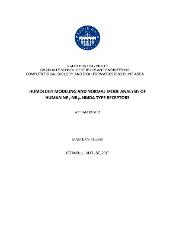Homology modeling and normal mode analysis of human NR1-NR2A NMDA type receptors
| dc.contributor.advisor | Gökhan Eşsiz, Şebnem | en_US |
| dc.contributor.author | Demir, Ayhan S. | |
| dc.date.accessioned | 2019-07-12T08:36:29Z | en_US |
| dc.date.available | 2019-07-12T08:36:29Z | en_US |
| dc.date.issued | 2017 | en_US |
| dc.identifier.uri | https://hdl.handle.net/20.500.12469/2041 | |
| dc.description.abstract | N-Methyl-D-Aspartate (NMDA) receptors are ionotropic glutamate receptors located in the membrane of the nerve cells. The normal receptor activity has a vital importance in consciousness and normal brain functions. Neuronal death occurs as a result of overstimulation of NMDA-type glutamate receptors and leads to diseases such as stroke epilepsy Alzheimer's and Parkinson's. There are two recently available x-ray structures one from Xenopus laevis and the other one from Rattus norvegicus. First the structures were analyzed and compared especially for ion channel parts by considering the general problems that arise when crystallizing structures of membrane proteins. Then human GluNR1-GluNR2A type NMDA receptor structure was modeled by homology modeling based on the Xenopus laevis template. NMDA receptor structure is a large membrane protein complex thus we followed a couple of different strategies such as modeling by the individual monomer modeling as a tetramer and modeling as a tetramer without loops then adding loops with loop modeling. Final models were chosen according to the model assessment scoring function. Subsequently elastic network analysis was used to understand the dynamics of the structural variations which govern the function of the protein. 20 slowest modes of NMDA receptor were examined according to 8 parameters which are found to be functionally important in previous NMDA studies. The 3th slowest mode was noticeable regarding to gating mechanism. in Mode 3 a twist motion of the TMD part rotates clockwise parallel to the membrane while LBD and TMD together rotate counter-clock wise parts cause opening of the channel. Mode 3 showed the relationship between TMD girdles LDB and M3-TMD linker. Similarly Mode 9 like Mode 3 showed the same relationship. in addition Mode 9 showed like a breathing motion or expansion motion along the channel axis. We hope that these modes will be tested by a more through all atom molecular dynamics study of apo and ligand bound human NMDA structure in the near future. | en_US |
| dc.description.abstract | N-Metil-D-Aspartat (NMDA) reseptörleri sinir hücrelerinin zarında bulunan iyonotropik glutamat reseptörleridir. Normal reseptör aktivitesi, bilinçlilik ve normal beyin işlevlerinde hayati öneme sahiptir. Nöronal ölüm, NMDA tipi glutamat reseptörlerinin aşırı uyarılması sonucu ortaya çıkar ve inme, epilepsi, Alzheimer ve Parkinson gibi hastalıklara neden olur. Xenopus laevis ve Rattus norvegicus olmak üzere yakın zamanda iki yeni x-ışını yapısı elde edilmiştir. Yapılar, zar proteinlerinin yapılarını kristalize ederken ortaya çıkan genel problemler göz önüne alınarak analiz edilmiştir. Bu çalışmada, insan GluNR1-GluNR2A tipi NMDA reseptör yapısı, Xenopus laevis şablonuna dayalı homoloji modellemesi ile modellendi. Sonra Elastic Network analizi yapıldı. Daha sonra, NMDA reseptörü nispeten büyük bir sistem olduğundan ve modelleme geometrik parametrelerin optimizasyonu olduğundan, tek tek monomerler üzerinden modelleme, tetramer halinde modelleme, döngüler olmadan bir tetramer olarak modelleme ve ardından döngü modellemesi gibi birkaç farklı strateji izlendi. İnsan NMDA reseptörü için homoloji modellemesi yapılmıştır. Puanlama fonksiyonuna göre modeller seçildi ve daha sonra, proteinin fonksiyonunu düzenleyen yapısal değişkenliklerin dinamiklerini anlamak için ENM ile NMA gerçekleştirildi. NMDA reseptörünün en yavaş modları olan 20 mod, 8 parametreye göre incelendi. Kapı mekanizması ile ilgili olarak 3. en yavaş mod dikkat çekici bulunmuştur. Mod 3'te, membrana paralel olarak TMD'nin saat yönünde dönerken, LBD ve TMD'nin birlikte saat yönünün tersine dönmesi ile oluşan twist hareketi kanalın açılmasına neden olur. Mode 3'de TMD girdle, LDB ve M3 TMD bağlantısı arasındaki ilişki gözlenmiştir. Benzer şekilde, Mod 9'da da, Mod 3 gibi bu ilişki gözlenmiştir. Ek olarak Mod 9, kanal ekseni boyunca bir nefes alma hareketi veya genişleme hareketi gibi hareket etmektedir. Bu modların yakın gelecekte apo ve ligand bağlı insan NMDA yapısının Moleküler Dinamik çalışmalarıyla daha iyi test edileceğini umuyoruz. | en_US |
| dc.language.iso | eng | en_US |
| dc.publisher | Kadir Has Üniversitesi | en_US |
| dc.rights | info:eu-repo/semantics/openAccess | en_US |
| dc.subject | N/A | en_US |
| dc.title | Homology modeling and normal mode analysis of human NR1-NR2A NMDA type receptors | en_US |
| dc.type | masterThesis | en_US |
| dc.department | Enstitüler, Lisansüstü Eğitim Enstitüsü, Hesaplamalı Biyoloji ve Biyoinformatik Ana Bilim Dalı | en_US |
| dc.relation.publicationcategory | Tez | en_US |
| dc.identifier.yoktezid | 470075 | en_US |
Files in this item
This item appears in the following Collection(s)
-
Tez Koleksiyonu [1348]
Thesis Collection
















